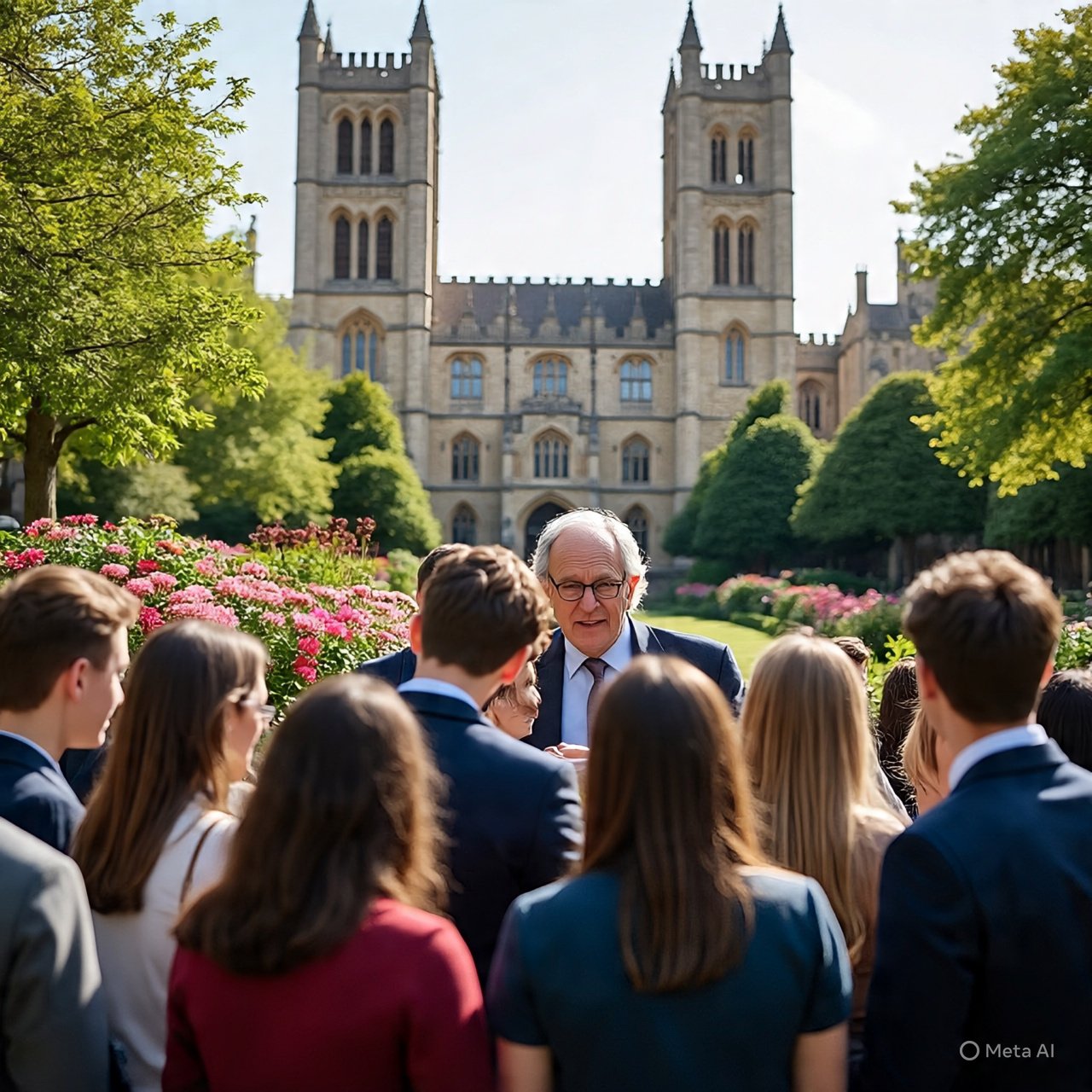🏛️ Introduction: Convergence of Ancient Times and Modernity
University of Oxford is the world’s oldest English-speaking university, founded around 1096, and continues to shine as a bright star in the field of global education and research. Oxford’s history is not only a golden chapter in British but also in global academic history, having established new standards in education and research.
Introduction: Convergence of Ancient Times and Modernity
University of Oxford is the world’s oldest English-speaking university, founded around 1096, and continues to shine as a bright star in the field of global education and research. Oxford’s history is not only a golden chapter in British but also in global academic history, having established new standards in education and research. This university is at the forefront of both its glorious traditions and modern leadership, where future sciences are being discovered in state-of-the-art laboratories within ancient building walls. Oxford’s educational model is based on its college system where 39 autonomous colleges operate under one unified university – this unique structure provides students with an integrated educational environment. Its libraries, museums, and research centers are filled with treasures of knowledge, while the university’s alumni include 72 Nobel laureates who fully reflect its academic standards. Oxford not only preserves the academic traditions of the past but is also committed to solving future challenges, where this beautiful blend of tradition and modernity makes it one of the world’s distinguished universities.
Historical Context: The Glorious Journey from 1096 to Present
The history of University of Oxford began around 1096 when formal education started in England. In the early period, the university was under church influence and taught theology, law, medicine, and arts. In 1167, Oxford developed rapidly after King Henry II’s decree when English students were prevented from going to the University of Paris. In 1188, Oxford is first mentioned in history when historian Gerald of Wales gave lectures here. In 1209, some Oxford scholars left the university and established a new university in Cambridge. In 1214, Oxford University was formally chartered. In the 13th century, the university’s first colleges – University College, Balliol College, and Merton College – were established. In the 16th century, Oxford played an important role during the English Reformation. In 1571, the university was formally recognized under the Oxford University Act. In the 17th century, Oxford played a significant role during the English Civil War. In the 18th century, the university played an important role in the Enlightenment era. In the 19th century, Oxford adopted modern sciences and began teaching in physics, chemistry, and biology fields. In 1878, women were first allowed to take examinations. In 1920, women were given the right to receive degrees. In the 20th century, Oxford made revolutionary discoveries in fields like nuclear physics, DNA structure, and economics. Today Oxford is a modern university that maintains its traditions while being at the forefront of modern research.
College System: A Unique Educational Model
University of Oxford’s college system makes it unique from other world universities. This system consists of 39 autonomous colleges and 5 permanent private halls that operate under one unified university. Each college has its own administration, income sources, and traditions, but they all work under the university’s supervision. Colleges provide students with accommodation, food, academic support, and social activity facilities. Each college has its own library, dining hall, chapel, and common grounds. Students live in a family environment in their college where they receive personal attention and guidance. The college system’s biggest feature is its ‘tutorial system’ where students are taught in small groups on a weekly basis. This system establishes deep connections between students and teachers and maintains high academic standards. Oxford’s famous colleges include University College (1249), Balliol College (1263), Merton College (1264), Christ Church (1546), and St John’s College (1555). Each college has its specific culture and traditions that have been established for centuries.
Research Excellence: Expanding the Frontiers of Knowledge
University of Oxford is a global leader in research where thousands of research projects are conducted every year. The university’s researchers have made revolutionary discoveries in physics, chemistry, medicine, economics, and literature fields. Oxford scientists have made fundamental contributions in fields like penicillin, DNA structure, and modern economics. The university’s 72 Nobel laureates fully reflect its research standards. An important aspect of Oxford’s research is interdisciplinary collaboration, where experts from different fields work together. The university’s research centers include Department of Politics and International Relations, Oxford University Department of Engineering Science, and Oxford Centre for Diabetes and Metabolism. The university receives millions of pounds in research funding annually from government, industrial, and charitable sources. Oxford’s research quality is evident from its consistent top positions in global rankings.
Academic Programs: Quality and Diversity
University of Oxford’s academic programs span a wide range covering undergraduate, postgraduate, and research degrees. The university has four divisions: Humanities, Mathematical, Physical and Life Sciences, Medical Sciences, and Social Sciences. Each division operates through multiple departments. Oxford’s academic year consists of three terms: Michaelmas (October-December), Hilary (January-March), and Trinity (April-June). To maintain academic standards, the university has established a rigorous examination system. Students must complete weekly assignments, essays, and practical work. Oxford degrees are recognized worldwide for their high quality. The university’s famous academic programs include Philosophy, Politics and Economics (PPE), Medicine, Law, and Computer Science. In each program, students gain both fundamental theoretical knowledge and practical experience.
International Cooperation: Global Academic Community
University of Oxford has established its identity internationally and collaborates with universities worldwide. The university has students from over 140 countries comprising 45% of total students. Oxford has established partnerships with renowned universities in Europe, Asia, and America. The university’s Oxford Overseas Trust provides scholarships for international students. Oxford plays an important role in international research projects, particularly in the European Union’s Horizon 2020 program. The university’s international relations office represents Oxford worldwide. Oxford’s international partnerships include Oxford-Africa Programme, Oxford-India Partnership, and Oxford-China Centre. Special facilities exist for international students, including language courses, cultural programs, and advisory services.
Innovation Environment: Inventions and Entrepreneurship
University of Oxford promotes innovation and entrepreneurship. The university’s Oxford University Innovation helps commercialize research discoveries. ‘Oxford Science Park’ is one of Europe’s large science parks. University students and staff have established successful companies like Oxford AstraZeneca Vaccine, Sophos, and Darktrace. Oxford Innovation Forum supports new business ideas. The university patents over 150 new inventions annually. The success secret of the innovation environment lies in the university’s ‘Innovation Ecosystem’ which includes research institutions, investors, and industrial partners. Saïd Business School plays an important role in Oxford’s entrepreneurship programs.
Library and Museums: Treasures of Knowledge
University of Oxford’s library system is one of the world’s largest library systems comprising over 100 libraries. Bodleian Libraries contain over 13 million books. The university’s museums include Ashmolean Museum (world’s first university museum), Museum of Natural History, and Pitt Rivers Museum. These museums attract millions of visitors annually. Oxford’s libraries contain immense collections of rare books, manuscripts, and historical documents. The university’s digital library system provides global researchers access to knowledge. Library facilities are available 24/7 and students are provided with state-of-the-art research resources. Museums are not only centers of knowledge but also sources of education and entertainment for the public.
Student Life: A Comprehensive Experience
University of Oxford student life is rich with academic and social activities. The university has over 400 student organizations including sports, music, drama, and other activities. Oxford Union Society is the world’s famous debating society. Residential facilities, sports grounds, and recreational centers are available for students. Oxford students play active roles in various cultural and religious organizations. The university’s ‘Freshers’ Week’ organizes introductory programs for new students. Complete facilities are provided for student health and wellbeing, including medical centers, psychological counseling, and guidance services.
Sustainability Initiatives: Environmental Protection
University of Oxford has adopted a comprehensive sustainability policy. The university has set the target to become carbon neutral by 2035. Work is ongoing on renewable energy projects. Under the waste management system, 75% of waste is recycled. Solar panels have been installed on university campuses. State-of-the-art systems have been introduced for water conservation. The university has implemented a ‘Green Travel Plan’ promoting cycling and public transport. Oxford buildings are designed according to energy saving standards. The university’s sustainability initiatives have been recognized internationally.
Industrial Cooperation: From Knowledge to Industry
University of Oxford has established deep relationships with industry. The university’s industrial partnerships include pharmaceutical, technology, and engineering sectors. Oxford Science Park is one of Europe’s important science parks. The university’s industrial cooperation includes joint research projects, industrial placements, and training programs. Oxford’s industrial partners include global companies like AstraZeneca, Google, and Siemens. Industrial cooperation has played a vital role in giving practical shape to university research.
Cultural Heritage: Arts and Traditions
University of Oxford’s cultural heritage spans centuries. The university’s music, drama, and art traditions are alive. Events like Oxford Literary Festival present a blend of knowledge and culture. Daily worship ceremonies are held in university chapels. Oxford’s music tradition is very old, including Oxford University Press and Oxford Philharmonic Society. Among university drama groups, Oxford University Dramatic Society is famous. Oxford cultural events include May Week and Christmas celebrations. University museums and art galleries are open to the public.
Future Plans: New Challenges
University of Oxford has developed comprehensive plans for the future. The university’s Vision 2030 is to maintain global leadership in research and education. New campuses, updated curricula, and international partnerships are priorities. The university has prepared the ‘Oxford 2030’ Plan to bring improvements in education, research, and social impact sectors. New research facilities are being established. Digital education is being promoted. Special attention is being given to interdisciplinary research. The university has established new research centers to solve global problems.
Global Rankings: Recognition of Quality
University of Oxford consistently ranks at the top in global rankings. In QS World University Ranking 2024, Oxford was ranked the world’s third best university. Research quality, employer reputation, and international cooperation are important ranking factors. Oxford’s position is continuously improving in Times Higher Education World University Ranking. Oxford is also included in top universities in Shanghai Ranking. Oxford has achieved high scores in various ranking parameters. The university’s international reputation is the result of its students and staff’s hard work.
Conclusion: The Journey of Tradition and Modernity Continues
University of Oxford has been a center of knowledge and wisdom for nine centuries. This blend of tradition and modernity prepares Oxford for future challenges. The university is committed to keeping the doors of knowledge open for future generations. Oxford’s story is the story of the light of knowledge, which travels from past to present and from present to future. This university is not just an educational institution but a symbol of hope and progress. Oxford’s journey continues, and this journey is illuminated by the light of knowledge.


